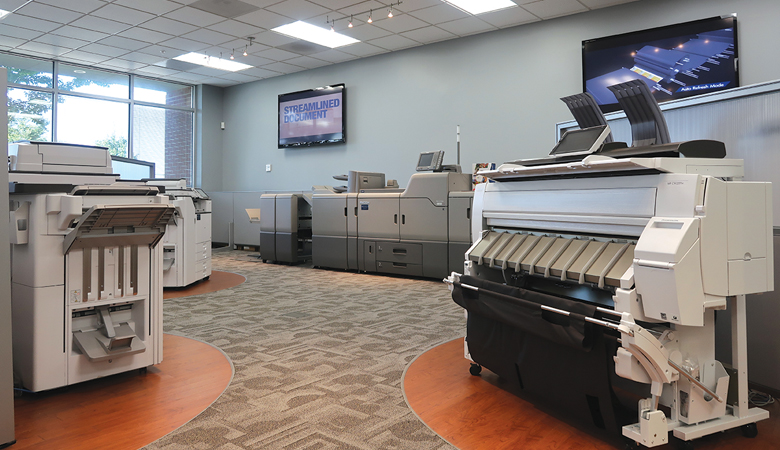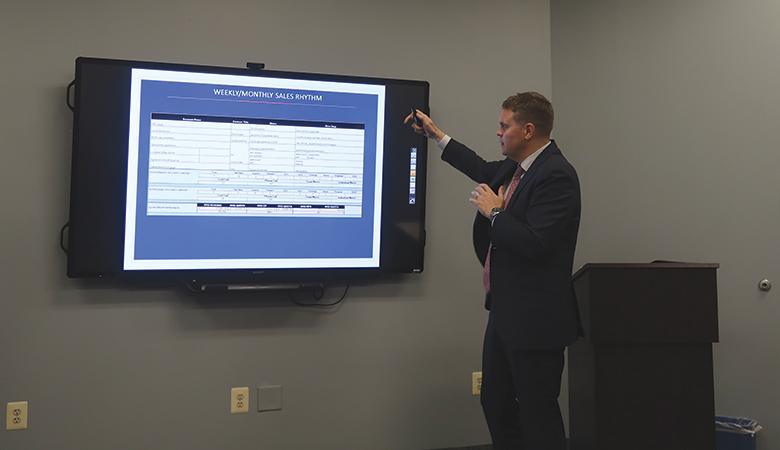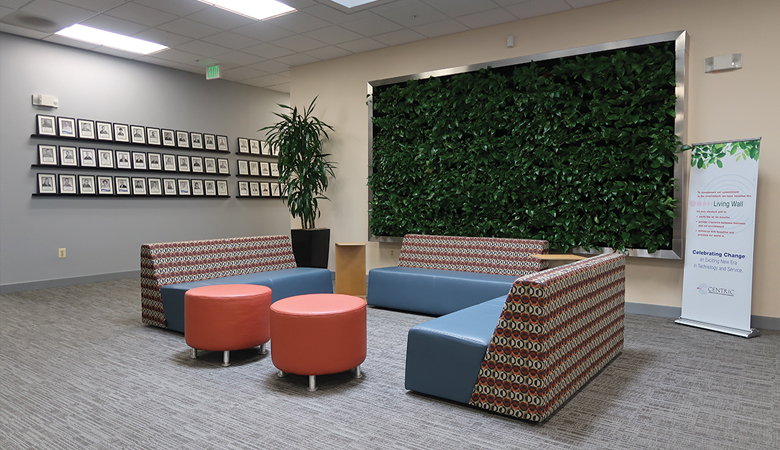Cooperation and Accountability Give Centric Business Systems a Competitive Edge
Above: Business Systems (from left to right): Rick Bastinelli, Frank, CJ and Carol Cannata, Felix Villanueva, Loralea Sanderson, and Scott Schabel.
Production Print display in showroom
One of the nice things about visiting dealers in Baltimore, at least for us, is that we can drive or take a train. Carol and I elected to drive, and CJ took the train from New York City. Our first stop was Centric Business Systems in Owings Mills, just outside Baltimore.
Centric Business Systems President Rick Bastinelli treated us as his personal guests. This was the first time Carol joined us on our dealer tour and after experiencing the VIP treatment at Centric, she commented, “No wonder you two are enjoying these dealer visits so much.”
Bastinelli’s team was primed and ready for our visit, and each member had prepared a special presentation about their segment of the business specifically for us. Bastinelli wanted to make sure we received the best possible information about not only how Centric goes to market, but also its mission and culture, and who better to share that information than the individuals responsible for those areas of the business. Presenters included Bastinelli; Scott Schnabel, executive vice president; Felix Villanueva, vice president, technical operations; Jesse Metruk, corporate training and development manager; and Diana Griffin, senior manager of customer service.
History Lesson
Centric was founded in August 1990 after Bastinelli acquired a struggling Savin branch. Within a year, Bastinelli’s fledgling company had a modest MIF of 200 units, two sales reps, 10 service techs, and $700,000 in revenue. Since then, the dealership has experienced a debt-free 28 consecutive years of growth and has established itself as one of the top Mid-Atlantic regional suppliers of imaging technology, solutions, and services.
Centric blankets the Mid-Atlantic region from seven locations serving Baltimore, Western Maryland, the Eastern Shore of Maryland, Northern Virginia, Richmond, South Central Pennsylvania, Philadelphia, Delaware, and Washington, D.C. Today, the dealership has 250 employees. Revenues have grown to $60 million, an increase of approximately $5 million from 2017. MIF has grown to 33,000, which generates 110,000,000 pages per month. Centric’s vendors include Sharp and Ricoh for A3, as well as printers and A4 MFPs from HP, which are critical components of the dealership’s managed print services offerings.
Bastinelli attributes his company’s ongoing growth to a combination of net new machine placements and five acquisitions. The latter has added MIF while expanding Centric’s geographic reach. The plan is to prudently pursue acquisition opportunities with the sweet spot of dealerships with revenues under $10 million. Prime acquisition targets within this price range are high-quality, organized, and operational document-related businesses (traditional copier dealers). However, Bastinelli expects to cast a wider net as Centric’s business evolves in managed IT.
Going forward, Bastinelli is looking to achieve a faster ROI from its acquisitions. Whereas a three-year ROI was once commonplace, increased competition to acquire in the marketplace, fueled in part by venture capital money, has extended the ROI on some acquisitions to as much as five years.
Scott Schnabel was one of several Centric executives who shared an in-depth presentation regarding the dealership’s business strategy.
Perhaps more than anything else, the fundamental reason for Centric’s success is a culture that requires all employees to demonstrate an uncompromising commitment to total customer satisfaction. As we learned during the presentations, all Centric employees must be supportive of their co-workers.
PULL QUOTE: Perhaps more than anything else, the fundamental reason for Centric’s success is a culture that requires all employees to demonstrate an uncompromising commitment to total customer satisfaction.
Central to Centric’s business model is the dealership’s customer retention department. Its mission is to make sure customers are satisfied with Centric as their provider and that the dealership’s service department’s goals are aligned with those of the customer retention department.
“I don’t run a service department; I run a customer retention department,” said Villanueva, during his presentation as he explained how important it is for his team to provide a great customer experience.
“But my real job is developing you to be adaptable for what might be coming next. In service, there is propensity to go, go, go. I want my people to really focus on where they are at the time.”
Accountability is critical to the performance of the company’s service operations, and at Centric, accountability is a two-way street. Techs know what needs to be done to meet the dealership’s expectations, but they are also challenged to hold leadership accountable for delivering what they set out to do.
“When you hear about it, you own it,” said Villanueva.
The Centric culture is one where employees take care of each other and work optimally together, no matter what department they are in. The goal is to avoid any potential silos that could exist within different departments.
Centric’s recruiting process is also important in the company’s efforts to ensure all the pieces fit nicely together. The dealership employs three internal recruiters who understand the dealership’s culture and the qualities Centric is looking for in an employee, and have a talent of getting beyond the superficial and directly to the core of each candidate to uncover a good fit. Candidates are prescreened by the recruiter, and evaluated by the Caliper Profile, an employee- and applicant-assessment instrument that measures an individual’s job performance potential. This approach has proven to be extremely beneficial, as sales turnover in the past seven months was only 14%. Compare that to the 40% to 60% turnover in sales personnel that most dealers cite.
“We make it very tough to get a job here,” said Metruk.
A living wall purifies the air and provides balance between business and the natural environment.
Bastinelli remains committed to the core business””hardware, software, solutions, MPS, production print, back-file scanning, and facilities management. The goal is to dominate in the markets they compete in and be the best. One way Centric achieves that aim is by employing a consultative approach. There’s a lot of mixing and matching of fleets, and Centric doesn’t rely on a single manufacturer to satisfy a customer’s needs. The solutions Centric proposes are customized to the customer.
“Sales reps have to be adaptable and changeable, and handle what’s happening in the marketplace,” explained Bastinelli. “We’re not looking to be the cheapest. We’re looking to be the best.”
The markets Centric serves are highly competitive with most competition today coming from other independent dealers. There’s still some competition from Konica Minolta direct, but mostly in GSA accounts, a business segment where Centric does not engage. Ricoh transferring its MIF to its independent dealers has also alleviated some of the competition from direct branches.
To better serve its growing customer base, Centric is planning to build a 36,000 square-foot distribution center next door to its Owings Mills headquarters, consolidating its three existing warehouse locations into the new building. The warehouse in its corporate headquarters will then be converted to office space.
PULL QUOTE: To better serve its growing customer base, Centric is planning to build a 36,000 square-foot distribution center next door to its Owings Mills headquarters, consolidating its three existing warehouse locations into the new building.
Meanwhile, Bastinelli and his team are looking at ways to maintain profitability and be competitive in the future by reviewing gross margins and the profitability of other B2B opportunities such as managed IT Services, professional services. business process automation, VoIP, and video conferencing. The plan is to go wider and deeper within Centric’s customer base and find new opportunities outside the base by providing additional products and services.
“We’re not going about this with our heads in the sand,” observed Bastinelli who added the company closely monitors the trends sweeping the imaging industry.
However, those opportunities must facilitate growth and be profitable. That careful approach to exploring new opportunities is one reason Centric has yet to take the plunge into managed IT. It’s not like they can’t do it. Bastinelli noted the dealership could easily flip the switch and be in the managed IT business today, but for now, the focus is on the core business. He’s confident the company will eventually move in that direction.
“It’s not a question of if, but when,” he said.
Access Related Content
Visit the www.thecannatareport.com. To become a subscriber, visit www.thecannatareport.com/register or contact cjcannata@cannatareport.com directly. Bulk subscription rates are also available.





